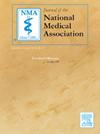种族和社会经济差异对贝伐单抗治疗视网膜静脉阻塞继发黄斑水肿短期疗效的影响。
IF 2.5
4区 医学
Q1 MEDICINE, GENERAL & INTERNAL
引用次数: 0
摘要
目的:抗vegf注射常用于视网膜静脉阻塞(RVO)引起的黄斑水肿的治疗。据报道,不同种族和民族对玻璃体内贝伐单抗治疗糖尿病黄斑水肿(DME)的反应不同。在这项回顾性研究中,我们研究了因种族和社会经济地位而导致的RVO继发黄斑水肿患者对贝伐单抗治疗反应的潜在差异。方法:纳入18岁以上接受至少一次玻璃体内贝伐单抗注射治疗中心或分支RVO的玻璃体内抗vegf naïve患者。收集治疗前、第一次注射后1-3个月(n = 148例150眼)和3次注射后1-3个月(n = 98例99眼)的数据。主要结局指标是患者视力(VA)改善的百分比(定义为>.1的最小分辨角尺度的对数),中央黄斑厚度(CMT)的减少,以及黄斑总体积(TMV)的减少。参与者的地址被用来计算区域剥夺指数(ADI),并被分类为低劣势(ADI的十分位数从1到5)或高劣势(ADI的十分位数从6到10)队列。通过多变量logistic回归分析VA改善的几率,通过多变量线性回归分析CMT和TMV的平均变化,以比较两个ADI队列以及黑人或非洲裔美国人和白人参与者在一次和三次注射后的治疗反应。结果:两组VA改善的几率无显著差异(1-注射:OR=1.24, p = 0.60;3次注射:OR=2.17, p = 0.23),CMT减少百分比(1次注射:-31.2 vs -27.5, p = 0.98;3次注射:-16.2 vs -32.7, p = 0.11),TMV减少百分比(1次注射:-15.5 vs -18.7, p = 0.44;3-注射:-11.6 vs-15.4, p = 0.60),控制人口统计学和临床因素。ADI组之间VA改善的几率、CMT减少的百分比和TMV减少的百分比没有显著差异(p > 0.05)。结论:种族间治疗反应无显著差异与现有RVO结果文献一致,然而,与我们在糖尿病黄斑水肿的研究结果相反,种族间治疗反应确实存在差异。社会经济地位的不同也没有显著差异。本文章由计算机程序翻译,如有差异,请以英文原文为准。
Impact of race and socioeconomic disparities on the short-term efficacy of bevacizumab for macular edema secondary to retinal vein occlusion
Purpose
Anti-VEGF injections are often used for the treatment of macular edema from retinal vein occlusions (RVO). Variable response to intravitreal bevacizumab has been reported for treatment of diabetic macular edema (DME) between racial and ethnic groups. We examined potential variances in treatment response to bevacizumab by race and socioeconomic status among patients with macular edema secondary to RVO in this retrospective study.
Methods
Intravitreal anti-VEGF naïve patients aged over 18 who received at least one intravitreal bevacizumab injection for central or branch RVO were included. Data were collected before treatment, 1–3 months after the first injection (n = 150 eyes of 148 patients), and 1–3 months after 3 injections (n = 99 eyes of 98 patients). Primary outcome measures were percentage of patients with visual acuity (VA) improvement (defined as >0.1 on the logarithm of minimum angle of resolution scale), reduction in central macular thickness (CMT), and reduction in total macular volume (TMV). Participant addresses were used to calculate Area Deprivation Index (ADI) and were categorized into low disadvantage (state ADI decile from 1 to 5) or high disadvantage (state ADI decile from 6 to 10) cohorts. Odds of VA improvement were analyzed via multivariate logistic regression and mean change in CMT and TMV were analyzed via multivariate linear regression to compare treatment responses among the two ADI cohorts and between Black or African American and White participants after one and three injections.
Results
There were no significant differences in the odds of VA improvement (1-injection: OR=1.24, p = 0.60; 3-injection: OR=2.17, p = 0.23), percent reduction in CMT (1-injection: −31.2 vs −27.5, p = 0.98; 3-injection: −16.2 vs −32.7, p = 0.11), and percent reduction in TMV (1-injection: −15.5 vs −18.7, p = 0.44; 3-injection: −11.6 vs-15.4, p = 0.60) after controlling for demographic and clinical factors. There were no significant differences in the odds of VA improvement, percent reduction in CMT, and percent reduction in TMV between ADI cohorts (p > 0.05).
Conclusions
The absence of significant differences in treatment response amongst race groups is congruent with existing literature on RVO outcomes, however, it contrasts our findings in diabetic macular edema which did show differences in treatment response between race groups. There were also no significant differences in treatment by socioeconomic status.
求助全文
通过发布文献求助,成功后即可免费获取论文全文。
去求助
来源期刊
CiteScore
4.80
自引率
3.00%
发文量
139
审稿时长
98 days
期刊介绍:
Journal of the National Medical Association, the official journal of the National Medical Association, is a peer-reviewed publication whose purpose is to address medical care disparities of persons of African descent.
The Journal of the National Medical Association is focused on specialized clinical research activities related to the health problems of African Americans and other minority groups. Special emphasis is placed on the application of medical science to improve the healthcare of underserved populations both in the United States and abroad. The Journal has the following objectives: (1) to expand the base of original peer-reviewed literature and the quality of that research on the topic of minority health; (2) to provide greater dissemination of this research; (3) to offer appropriate and timely recognition of the significant contributions of physicians who serve these populations; and (4) to promote engagement by member and non-member physicians in the overall goals and objectives of the National Medical Association.

 求助内容:
求助内容: 应助结果提醒方式:
应助结果提醒方式:


